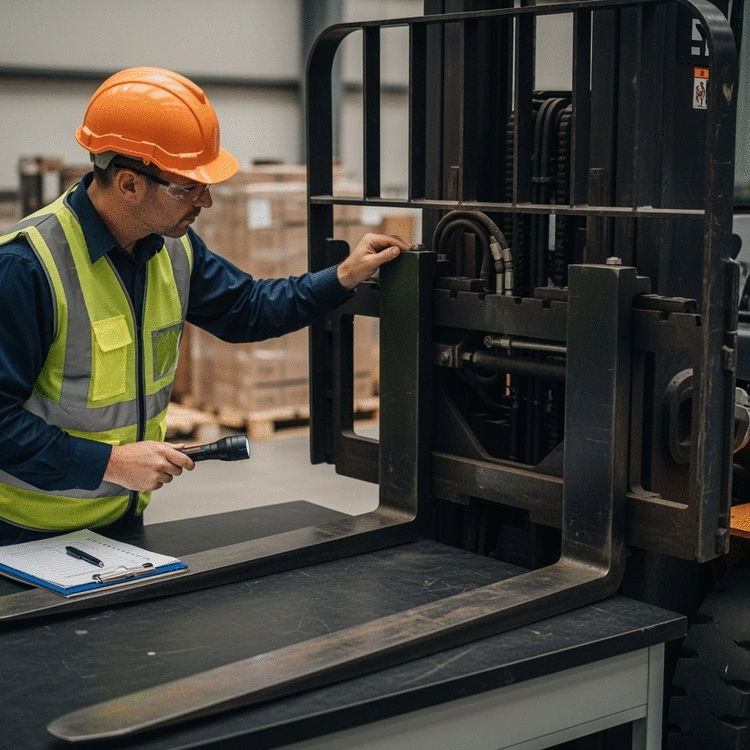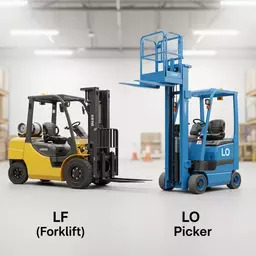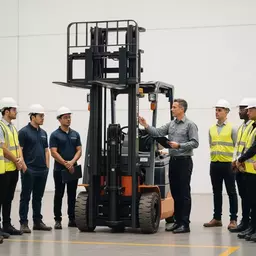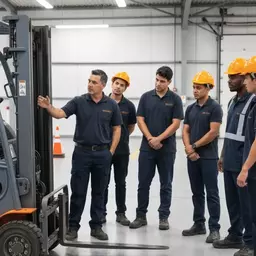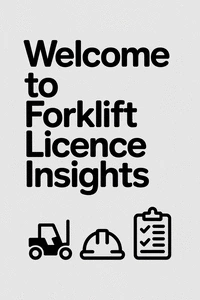Forklift inspections are often overlooked, yet they are a crucial element in maintaining a safe workplace. Did you know that regular checks can significantly reduce the risk of accidents and enhance compliance with safety regulations? Let's explore the essential insights on daily forklift safety inspections.
What You Will Learn
- Daily inspections are vital for promoting workplace safety and minimizing accident risks.
- Compliance with OSHA regulations is essential to protect both employees and employers.
- Key components of effective inspections include visual checks, fluid assessments, and operational tests.
- Fostering a culture of safety involves open communication and recognition of safe practices among operators.
- Detailed maintenance logs and inspection records are crucial for compliance and identifying recurring issues.
Key Elements for Forklift Safety and Compliance
Daily forklift safety inspections are paramount for a safe work environment and regulatory compliance. The visual below outlines the critical areas and processes involved.
Importance of Daily Inspections
- ✓ Promotes workplace safety
- ✓ Reduces risk of accidents
- ✓ Ensures OSHA compliance
- ✓ Improves equipment lifespan
OSHA Regulatory Standards
- ● Operators must perform daily checks.
- ● Regulations protect employees.
- ● Non-compliance leads to fines.
- ● High accident rate risks reputation.
Safety Checklist Components
- ■ Visual checks of safety features
- ■ Fluid level assessments
- ■ Tire condition evaluations
- ■ Operational tests (brakes/steering)
Culture of Safety
- ✓ Encourage open discussions.
- ✓ Reward safe practices.
- ✓ Provide training opportunities.
- ✓ Set clear safety expectations.
Next Steps: Training & Inspections
- ● Regular training for all operators.
- ● Continuous learning reinforces safety.
- ● Mitigate risks with consistency.
- ● Professional help for complex issues.
Maintenance Logs & Records
- ■ Record all inspection results.
- ■ Log maintenance and repairs.
- ■ Review logs for trends.
- ■ Ensure records are accessible.
Understanding Daily Forklift Safety Inspections
Daily forklift safety inspections are crucial for maintaining a safe work environment and ensuring compliance with industry regulations. At Forklift Licence Insights, we recognize that these inspections play a vital role in preventing accidents and promoting overall operational efficiency. By conducting thorough daily checks, we can identify and address potential issues before they escalate, safeguarding both operators and equipment! For more details on compliance, check out our guide on 2025 Australian Forklift Licence Changes.
Importantly, daily inspections help meet the requirements set forth by the Occupational Safety and Health Administration (OSHA). Compliance with these regulations not only protects employees but also shields employers from potential legal ramifications. Remember, prevention is always better than cure!
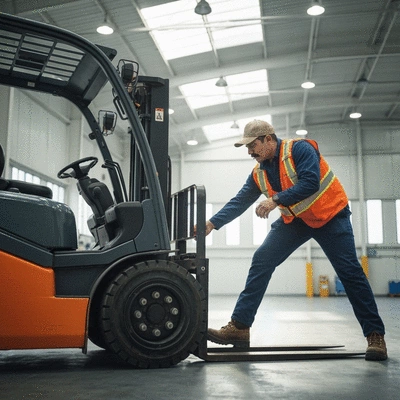
Importance of Daily Inspections for Forklift Safety
Daily inspections help us spot problems early and ensure that our forklifts run smoothly. Not only does this enhance safety, but it also boosts productivity by minimizing downtime. When we regularly check our equipment, we're investing in a culture of safety and responsibility.
- Promotes workplace safety
- Reduces risk of accidents
- Ensures compliance with OSHA regulations
- Improves equipment lifespan
By prioritizing daily inspections, we're taking essential steps toward fostering a safe and efficient working environment. It's all about being proactive and responsible!
Regulatory Standards: OSHA Requirements for Forklift Inspections
The OSHA guidelines outline specific requirements for forklift inspections to ensure safety in the workplace. For instance, operators must perform daily checks before starting the equipment. These regulations are not just formalities; they are put in place to protect everyone involved!
Failure to adhere to OSHA requirements can lead to serious consequences. Beyond potential fines, non-compliance may also result in increased accident rates, which can jeopardize employee safety and the company's reputation. Understanding these standards is fundamental for anyone involved in forklift operations. Learn more about general forklift safety rules for operators to ensure comprehensive compliance.
Key Components of a Safety Checklist
A comprehensive safety checklist is integral to effective daily inspections. It ensures that no crucial element is overlooked during the assessment process. Here are the key components that should always be included:
- Visual checks of safety features
- Fluid level assessments
- Tire condition evaluations
- Operational tests
Incorporating these components into our daily inspections helps maintain high safety standards and promotes compliance across the board. It’s essential to have a structured approach to these checks for the best outcomes!
Engage with the Community!
We want to know your thoughts! How often do you conduct daily forklift safety inspections in your workplace? Share your insights and experiences below:
Summarizing Effective Daily Forklift Safety Inspections
Key Takeaways for Ensuring Forklift Safety
Daily forklift safety inspections are not just a regulatory requirement; they are essential for ensuring workplace safety. By incorporating systematic checks into your routine, you can prevent accidents and ensure compliance with safety standards. Key components of these inspections include visual checks, fluid assessments, and operational tests, all of which contribute to a safer work environment.
Moreover, maintaining a consistent inspection schedule not only enhances safety but also supports your team’s confidence in operating forklifts. Remember, the more diligent we are about these inspections, the less likely we are to face safety issues or costly downtime!
- Visual checks for safety decals and labels
- Fluid level assessments
- Tire condition evaluations
- Operational tests for brakes and steering
- Regular documentation of all findings
By focusing on these vital steps, you help create a culture of safety and responsibility among your forklift operators. It’s a small investment of time that can lead to significant gains in safety and efficiency!
Encouraging a Culture of Safety in the Workplace
Fostering a culture of safety is paramount in any workplace, particularly for forklift operators. This means not only enforcing safety protocols but also encouraging open communication about safety concerns. As someone passionate about workplace safety, I believe that when operators feel empowered to report potential issues, it leads to a healthier work environment.

Management plays a crucial role in this culture. Regularly discussing safety during team meetings and recognizing safe practices can motivate operators to prioritize safety in their daily tasks. This collaborative approach helps build trust and accountability, which are fundamental for any efficient and safe operation.
- Encourage open discussions about safety concerns
- Recognize and reward safe practices
- Provide opportunities for team training and workshops
- Set clear expectations around safety compliance
Creating a safety-oriented culture is an ongoing commitment, and every team member plays a part! It’s about working together to ensure that everyone goes home safe at the end of the day.
Next Steps for Forklift Operators and Employers
Implementing Regular Training and Inspections
As we navigate the world of forklift operations, regular training and inspections should always be a priority. It's crucial to implement these practices as standard protocol for all operators, not just new hires. Continuous learning not only enhances skills but also reinforces safety knowledge, ensuring that everyone remains vigilant and informed.
Remember, training can take many forms! From formal classes offered by accredited training organisations to on-the-job training sessions, each method contributes to a more knowledgeable team. Consistency in training and inspections can significantly mitigate risks in the workplace.
Getting Professional Help When Needed
We all know that while daily inspections cover a lot, some issues may require professional expertise. If you encounter problems beyond the scope of a standard inspection, seeking expert assistance is wise. This not only ensures that repairs are handled safely but also keeps your equipment in optimal condition.
Don’t hesitate to connect with maintenance services when necessary! Remember, addressing issues early can save you time and money down the line, and keep your operations running smoothly. For comprehensive training resources, consider our forklift licence training guide in Australia.
Creating Maintenance Logs and Inspection Records
Lastly, maintaining detailed logs for all inspections and repairs is crucial for compliance and effective safety management. These records serve as a valuable reference and can be essential during audits or safety inspections. They also provide insights into recurring issues, helping you to address them proactively.
Here are some key points to remember about documentation:
- Record all inspection results, including any identified issues
- Log maintenance and repair work performed
- Review logs regularly to identify trends and areas for improvement
- Ensure all records are accessible for audits and inspections
At Forklift Licence Insights, we emphasize the importance of thorough documentation as part of our mission to promote safety and compliance. Together, we can ensure that every forklift operator is prepared for success!
Frequently Asked Questions (FAQs)
- Why are daily forklift inspections important?
- Daily forklift inspections are crucial for maintaining a safe work environment, reducing the risk of accidents, ensuring compliance with OSHA regulations, and improving the lifespan of the equipment.
- What are the OSHA requirements for forklift inspections?
- OSHA mandates that operators perform daily checks before using the equipment. These regulations are designed to protect employees and prevent accidents, and non-compliance can lead to fines and reputational damage.
- What key components should be included in a forklift safety checklist?
- A comprehensive safety checklist should include visual checks of safety features, fluid level assessments, tire condition evaluations, and operational tests (e.g., brakes and steering).
- How can a workplace foster a culture of forklift safety?
- Fostering a safety culture involves encouraging open discussions about safety concerns, recognizing and rewarding safe practices, providing regular training opportunities, and setting clear safety expectations for all operators.
- Why is maintaining maintenance logs and inspection records important?
- Detailed maintenance logs and inspection records are essential for compliance, serve as valuable references during audits, and help identify recurring issues to enable proactive maintenance and problem-solving.
Recap of Key Points
Here is a quick recap of the important points discussed in the article:
- Daily forklift safety inspections are essential for maintaining a safe work environment and ensuring compliance with OSHA regulations.
- Regular inspections help identify potential issues early, reducing the risk of accidents and enhancing productivity.
- Key components of a safety checklist include visual checks, fluid assessments, tire evaluations, and operational tests.
- Encouraging open communication about safety and recognizing safe practices fosters a culture of safety among operators.
- Maintaining detailed inspection logs aids compliance and helps identify recurring issues for proactive management.
